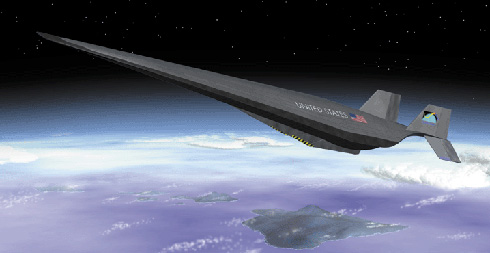
| Home | Bottom |
| SPACE | TRANSPORT: | Spacecraft : | Hypersoar |

The HyperSoar is a B-52 sized hypersonic bomber/recon aircraft concept under investigation by US DoE's Lawrence Livermore National Laboratory and University of Maryland. If developed, it would have the capability to take-off from the US and deliver its goods anywhere in the world in a couple of hours without refueling. It's speed(Mach 10) and altitude will make it near impossible to track it, much less bring it down. It's chief designer is Preston Carter
Hypersoar will fly only at 'the edge of space' - 60 km - however, it needs technology that will more than just distinguish it from 'conventional' airplanes.
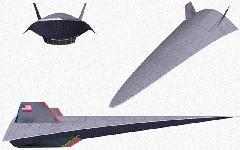
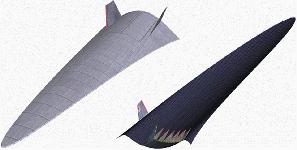
The HyperSoar escapes heat build-up on the airframe by skipping along the edge of Earth's atmosphere - much like a rock skipped across water. A HyperSoar aircraft would ascend to power outside the Earth's atmosphere - then turn off its engines and coast back to the surface of the atmosphere. There, it would again fire its air-breathing engines and skip back into space. The craft would repeat this process until it reached its destination. A flight from US to Japan will take 25 such skips.
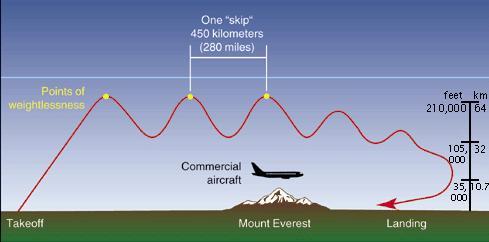
The skips will be angled at only 5 degrees. The passengers will feel a force of 1.5 Gs which what you would experience on a child's swing. The plane will powerup to 39 kms, from where it will coast to double that altitude, before it starts to descend. Each skip will be 450 kms long.
All previous concepts have suffered from heat buildup on the surface of the aircraft and in various aircraft components due to friction with the atmosphere. A HyperSoar plane would experience less heating because it would spend much of its flight out of the Earth's atmosphere. Also, any heat the craft picked up while "skipping" down into the atmosphere could be at least partially dissipated during the aircraft's time in space(it is cold out there).
HyperSoar has a promised fuel efficiency comparable to today's commercial aeroplanes. However, possible adverse environmental effects from emissions or sonic booms have not been looked into, which have plagued attempts to develop slower, supersonic transport planes.
The core of hypersoar is the engine - especially since it is a waverider design i.e. the whole body is integrated with the engine so that the whole plane can 'ride' the shock wave. This being the reason why all hypersonic concepts, including X-43, X-30 look so similar.
Ofcourse, air breathing engines at that height have to be SCRAMJETS or something similar. These are currently being developed in the X-43 Hyper-X program.
Is Hyper-Soar US' next strategic bomber? Probably not. Infact, B-3 will not even be supersonic. The B3 bomber is a subsonic extension of the existing B-2 Spirit flying wing. US Air Combat Command initiated the Future Stirke Aircraft or FSA study with the nation's three prime contractors for airframes - Boeing, Lockheed Martin and Northrop Grumman to look ahead and develop concpts for the heavy bomber. Couple of years ago, Nothrop Grumman came out with 2 different design studies. One hypersonic waverider, another a Mach 2 supercruiser. The third design was not revealed.
| Stats | |
|---|---|
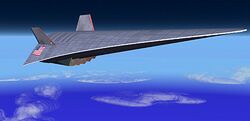 |
|
| Length : | 25 m |
| Propulsion : | Air Breathing Rockets |
| Max. Speed : | Mach 10 |
| Ceiling : | 60 km |
Also See :
| Spacecraft Tech | : | Hypersonic Flight and Scramjets |
| Spacecraft Tech | : | HTOL TSTO |
| Spacecraft Tech | : | X-43 Hyper-X |
| Spacecraft | : | AVATAR |
| Spacecraft | : | Tu-2000 |
| Spacecraft | : | MiG-2000 |
| llnl.gov/PAO/NewsReleases/1998/NR-98-09-04.html : Lawrence National Laboratory press release |
| fas.org/man/dod-101/sys/ac/hypersoar.htm : FAS page on Hyper Soar |

Mail ST at [email protected] . Your suggestions are welcome.
| [ Home ] | [ Aircraft ] | [ Explore Space ] | [ Space Stations] | [ Spacecraft Tech ] | [ Spacecraft ] | [ X-Prize ] |